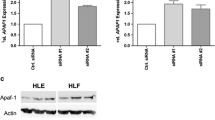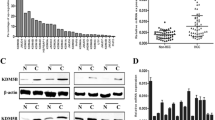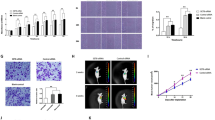Abstract
Histone deacetylases (HDACs) play a critical role in the proliferation, differentiation, and apoptosis of cancer cells. An obstacle for the application of HDAC inhibitors as effective anti-cancer therapeutics is that our current knowledge on the contributions of different HDACs in various cancer types remains scarce. The present study reported that the mRNA and protein levels of HDAC5 were up-regulated in human hepatocellular carcinoma (HCC) tissues and cells as shown by quantitative real-time PCR and Western blot. MTT assay and BrdU incorporation assay showed that the down-regulation of HDAC5 inhibited cell proliferation in HepG2, Hep3B, and Huh7 cell lines. Data from in vivo xenograft tumorigenesis model also demonstrated the anti-proliferative effect of HDAC5 depletion on tumor cell growth. Furthermore, the suppression of HDAC5 promoted cell apoptosis and induced G1-phase cell cycle arrest in HCC cells. On the molecular level, we observed altered expression of apoptosis-related proteins such as p53, bax, bcl-2, cyto C, and caspase 3 in HDAC5-shRNA-transfected cells. Knockdown of HDAC5 led to a significant up-regulation of p21 and down-regulation of cyclin D1 and CDK2/4/6. We also found that the down-regulation of HDAC5 substantially increased p53 stability and promoted its nuclear localization and transcriptional activity. Our study suggested that knockdown of HDAC5 could inhibit cancer cell proliferation by the induction of cell cycle arrest and apoptosis; thus, suppression of HDAC5 may be a viable option for treating HCC patients.






Similar content being viewed by others
References
El-Serag HB. Hepatocellular carcinoma. N Engl J Med. 2011;365:1118–27.
Yang Y, Jin C, Li H, et al. Improved radiosensitizing effect of the combination of etanidazole and paclitaxel for hepatocellular carcinoma in vivo. Exp Ther Med. 2012;3:299–303.
Zhang C, Ling Y, Zhang C, et al. The silencing of reck gene is associated with promoter hypermethylation and poor survival in hepatocellular carcinoma. Int J Biol Sci. 2012;8:451–8.
Minagawa M, Makuuchi M, Takayama T, et al. Selection criteria for repeat hepatectomy in patients with recurrent hepatocellular carcinoma. Ann Surg. 2003;238:703–10.
Johnson FM, Saigal B, Talpaz M, et al. Dasatinib (BMS-354825) tyrosine kinase inhibitor suppresses invasion and induces cell cycle arrest and apoptosis of head and neck squamous cell carcinoma and non-small cell lung cancer cells. Clin Cancer Res. 2005;11:6924–32.
Yan K, Zhang C, Feng J, et al. Induction of G1 cell cycle arrest and apoptosis by berberine in bladder cancer cells. Eur J Pharmacol. 2011;661:1–7.
West AC, Mattarollo SR, Shortt J, et al. An intact immune system is required for the anticancer activities of histone deacetylase inhibitors. Cancer Res. 2013;73:7265–76.
Sebastian C, Zwaans BM, Silberman DM, et al. The histone deacetylase SIRT6 is a tumor suppressor that controls cancer metabolism. Cell. 2012;151:1185–99.
Mottet D, Pirotte S, Lamour V, et al. HDAC4 represses p21(WAF1/Cip1) expression in human cancer cells through a Sp1-dependent, p53-independent mechanism. Oncogene. 2009;28:243–56.
Wilson AJ, Byun DS, Nasser S, et al. HDAC4 promotes growth of colon cancer cells via repression of p21. Mol Biol Cell. 2008;19:4062–75.
Zhu C, Chen Q, Xie Z, et al. The role of histone deacetylase 7 (HDAC7) in cancer cell proliferation: regulation on c-Myc. J Mol Med (Berl). 2011;89:279–89.
Wagner JM, Hackanson B, Lubbert M, et al. Histone deacetylase (HDAC) inhibitors in recent clinical trials for cancer therapy. Clin Epigenetics. 2010;1:117–36.
Zhang Y, Matkovich SJ, Duan X, et al. Receptor-independent protein kinase c alpha (PKCalpha) signaling by calpain-generated free catalytic domains induces HDAC5 nuclear export and regulates cardiac transcription. J Biol Chem. 2011;286:26943–51.
Osada H, Tatematsu Y, Saito H, et al. Reduced expression of class ii histone deacetylase genes is associated with poor prognosis in lung cancer patients. Int J Cancer. 2004;112:26–32.
Milde T, Oehme I, Korshunov A, et al. HDAC5 and HDAC9 in medulloblastoma: novel markers for risk stratification and role in tumor cell growth. Clin Cancer Res. 2010;16:3240–52.
Lachenmayer A, Toffanin S, Cabellos L, et al. Combination therapy for hepatocellular carcinoma: additive preclinical efficacy of the hdac inhibitor panobinostat with sorafenib. J Hepatol. 2012;56:1343–50.
Liu H, Li P, Zhai Y, et al. Diagnostic value of glypican-3 in serum and liver for primary hepatocellular carcinoma. World J Gastroenterol. 2010;16:4410–5.
Glaser KB, Li J, Staver MJ, et al. Role of class I and class II histone deacetylases in carcinoma cells using siRNA. Biochem Biophys Res Commun. 2003;310:529–36.
Valenzuela-Fernandez A, Cabrero JR, Serrador JM, et al. HDAC6: a key regulator of cytoskeleton, cell migration and cell-cell interactions. Trends Cell Biol. 2008;18:291–7.
Lee CK, Wang S, Huang X, et al. HDAC inhibition synergistically enhances alkylator-induced dna damage responses and apoptosis in multiple myeloma cells. Cancer Lett. 2010;296:233–40.
Peixoto P, Castronovo V, Matheus N, et al. HDAC5 is required for maintenance of pericentric heterochromatin, and controls cell-cycle progression and survival of human cancer cells. Cell Death Differ. 2012;19:1239–52.
La Vignera S, Condorelli R, Vicari E, et al. Effects of varicocelectomy on sperm DNA fragmentation, mitochondrial function, chromatin condensation, and apoptosis. J Androl. 2012;33:389–96.
Ren W, Beebe SJ. An apoptosis targeted stimulus with nanosecond pulsed electric fields (nsPEFs) in E4 squamous cell carcinoma. Apoptosis. 2011;16:382–93.
Weinert T, Hopper AK. tRNA traffic meets a cell-cycle checkpoint. Cell. 2007;131:838–40.
Bai Y, Mao QQ, Qin J, et al. Resveratrol induces apoptosis and cell cycle arrest of human T24 bladder cancer cells in vitro and inhibits tumor growth in vivo. Cancer Sci. 2010;101:488–93.
Yang L, Besschetnova TY, Brooks CR, et al. Epithelial cell cycle arrest in G2/M mediates kidney fibrosis after injury. Nat Med. 2010;16(535–43):1–143.
McKinsey TA, Zhang CL, Lu J, et al. Signal-dependent nuclear export of a histone deacetylase regulates muscle differentiation. Nature. 2000;408:106–11.
Ropero S, Esteller M. The role of histone deacetylases (HDACs) in human cancer. Mol Oncol. 2007;1:19–25.
Richon VM, Sandhoff TW, Rifkind RA, et al. Histone deacetylase inhibitor selectively induces p21WAF1 expression and gene-associated histone acetylation. Proc Natl Acad Sci U S A. 2000;97:10014–9.
Zhao Y, Tan J, Zhuang L, et al. Inhibitors of histone deacetylases target the Rb-E2F1 pathway for apoptosis induction through activation of proapoptotic protein Bim. Proc Natl Acad Sci U S A. 2005;102:16090–5.
Kramer OH, Gottlicher M, Heinzel T. Histone deacetylase as a therapeutic target. Trends Endocrinol Metab. 2001;12:294–300.
Marks PA, Richon VM, Breslow R, et al. Histone deacetylase inhibitors as new cancer drugs. Curr Opin Oncol. 2001;13:477–83.
Hu W, Ge Y, Ojcius DM, et al. P53 signalling controls cell cycle arrest and caspase-independent apoptosis in macrophages infected with pathogenic leptospira species. Cell Microbiol. 2013;15:1642–59.
Qiao D, Meyer K, Friedl A. Glypican-1 stimulates Skp2 autoinduction loop and G1/S transition in endothelial cells. J Biol Chem. 2012;287:5898–909.
Abe K, Naruse C, Kato T, et al. Loss of heterochromatin protein 1 gamma reduces the number of primordial germ cells via impaired cell cycle progression in mice. Biol Reprod. 2011;85:1013–24.
Jin L, Li C, Xu Y, et al. Epigallocatechin gallate promotes p53 accumulation and activity via the inhibition of MDM2-mediated p53 ubiquitination in human lung cancer cells. Oncol Rep. 2013;29:1983–90.
Yuan J, Luo K, Zhang L, et al. Usp10 regulates p53 localization and stability by deubiquitinating p53. Cell. 2010;140:384–96.
Acknowledgments
This research was supported by the State Major Science and Technology Special Projects during the period of China State 12th 5-year plan (grant 2012ZX10002).
Conflicts of interest
None
Author information
Authors and Affiliations
Corresponding author
Additional information
Jian Fan and Bin Lou contributed equally to this work.
Rights and permissions
About this article
Cite this article
Fan, J., Lou, B., Chen, W. et al. Down-regulation of HDAC5 inhibits growth of human hepatocellular carcinoma by induction of apoptosis and cell cycle arrest. Tumor Biol. 35, 11523–11532 (2014). https://doi.org/10.1007/s13277-014-2358-2
Received:
Accepted:
Published:
Issue Date:
DOI: https://doi.org/10.1007/s13277-014-2358-2




